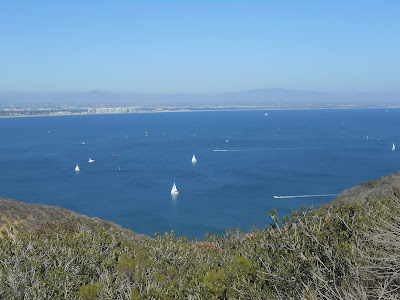We continued up to the Old Point Loma Lighthouse. From the National Park Service (link),
The Old Point Loma Lighthouse stood watch over the entrance to San Diego Bay for 36 years. At dusk on November 15, 1855, the light keeper climbed the winding stairs and lit the light for the first time. What seemed to be a good location 422 feet above sea level, however, had a serious flaw. Fog and low clouds often obscured the light. On March 23, 1891, the light was extinguished and the keeper moved to a new lighthouse location closer to the water at the tip of the Point.
Today, the Old Point Loma Lighthouse still stands watch over San Diego, sentinel to a vanished past. The National Park Service has refurbished the interior to its historic 1880s appearance - a reminder of a bygone era. Ranger-led talks, displays, and brochures are available to explain the lighthouse’s interesting past.
The Point Loma peninsula forms a natural protective barrier at the entrance to San Diego Bay, rising 422 feet to provide strategic views of the harbor and ocean. In 1852, the government of the United States recognized the importance of this sandstone rampart and designated the area as a military reserve. In 1899, the War Department dedicated Fort Rosecrans and built a series of gun batteries over the years.
During World War I and II, military facilities on the Point provided vital coastal and harbor defense systems. Between 1918 and 1943, the Army constructed searchlight bunkers, fire control stations, and gun batteries. The largest guns were at Battery Ashburn, adjacent to the park entrance station, where two 16-inch guns could fire 2,300 pound shells nearly 30 miles out to sea.
Point Loma offers views of the migrating whales.
We walked down to the Cabrillo Monument, passing the panorama of San Diego Bay leading to the Pacific Ocean. Mexico is in the distance.
Coronado Island came into view ...
... with a passing container ship heading out to sea. I can't imagine sailing by the container ship in a sailboat!
Cabrillo National Monument, established in 1913, commemorates Juan Rodriguez Cabrillo's voyage of discovery. A heroic statue of Cabrillo looks out over the bay that he first sailed into on September 28, 1542. At the Visitor Center, the film "In Search of Cabrillo" and an exhibit hall present Cabrillo's life and times. Ranger-led programs about Cabrillo are usually available on weekends and on many weekdays during summer months.
We also spotted Naval Base Point Loma, home to the Submarine Base, Naval Mine and Anti-Submarine Warfare Command, Fleet Combat Training Center Pacific, Space and Naval Warfare Systems Command (SPAWAR), and the Fleet Intelligence Command Pacific.
On our drive back back to Downtown San Diego, I spotted these signs - my brother was named Byron.
I am giving away a book choice from my convention stash to one randomly selected commenter from this week's posts. To enter the giveaway,
1. Leave a comment about lighthouses - do you have a favorite? Of course I love the lighthouses of Hawaii!
2. Comments are open through Saturday, August 6, 10 pm in Baltimore.
3. I'll post the winner on Sunday, August 7, on SOS Aloha.
Mahalo,
Kim in Baltimore
Aloha Spirit in Charm City
Old Glory flying on the mast outside the visitors' center.





















































